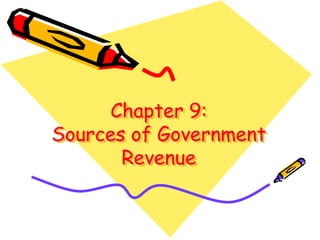
Chapter 9
- 1. Chapter 9:Sources of Government Revenue
- 2. 9-1: The Economics of Taxation Economic Impact of Taxes Resource allocation – when taxes are raised on a product, consumers buy less, manufacturers produce less, and resources will have to go to other industries to be employed Behavior adjustment - taxes can be used to encourage or discourage certain types of activities By changing incentives to save, invest and work, taxes affect productivity and growth
- 3. Criteria for Effective Taxes Equity - fair Simplicity – easy to understand Efficiency – benefits outweigh costs Two Principles of Taxation: Benefit Principle – belief that taxes should be paid based on benefits received, regardless of income Ability to Pay Principle – belief that taxes should be paid according to the level of income, regardless of benefits received
- 4. Three Types of Taxes 1. Proportional Tax – as income goes up, the percentage of income paid in taxes stays the same 2, Progressive Tax – as income goes up, the percentage of income paid in taxes goes up 3. Regressive Tax - as income goes up, the percentage of income paid in taxes goes down
- 5. 9-2: Federal, State, and Local Revenue Systems Federal Government Revenue Sources (in order of size) 1. Individual Income Taxes – collected with a payroll withholding system that automatically deducts income taxes from paychecks 2. FICA Taxes - Federal Insurance Contributions Act - tax levied on employers and employees to support Social Security and Medicare - also automatically deducted from paycheck 3. Borrowing 4. Corporate Income Taxes 5. Excise Taxes – tax on manufacture or sell of selected items such as gasoline and liquor
- 6. 6. Estate and Gift Taxes 7. Customs Duties 8. Miscellaneous Fees
- 8. State Government Revenue Sources (in order of size) 1. Intergovernmental Revenues – funds collected by one level of government that is distributed to another level of government for expenditures 2. Sales Taxes - general tax levied on consumer goods - 5 states do not have a general sales tax 3. Individual Income Taxes - only 7 states do not rely on individual income taxes for revenue - varies widely from state to state 4. Other Revenues - interest earnings - tuition and fees - corporate income taxes
- 9. Local Government Revenue Sources (in order of size) 1. Intergovernmental Revenues 2. Property Taxes - tax on tangible and intangible possessions such as real estate, buildings, furniture, stocks, bonds and bank accounts 3. Utility Revenues - public utility companies that supply water, electricity, sewer, and sometimes telecommunications are often owned by local governments 4. Sales Taxes 5. Other Revenue Sources - interest earnings - fees - borrowing
- 12. 9-3: Current Tax Issues and Reforms Current Tax Code is incredibly complex Tax Reform: 1981 Economic Recovery Tax Act included large tax deductions for individuals and businesses, accelerated depreciation, and investment tax credits Tax Reform: 1986 Tax Reform: 1993 Tax Reform: 1997 Tax Reform: 2001 Tax Reform: 2003 Permanent tax cuts by 2011?
- 13. Alternative Tax Approaches Flat Tax – a proportional tax on individual income Simple Closes “loopholes” Save $$ and time preparing tax returns Removes incentives in current tax code Value-Added Tax – Tax consumption, not income Equivalent to a national sales tax Tax on the value added at every stage of the production process